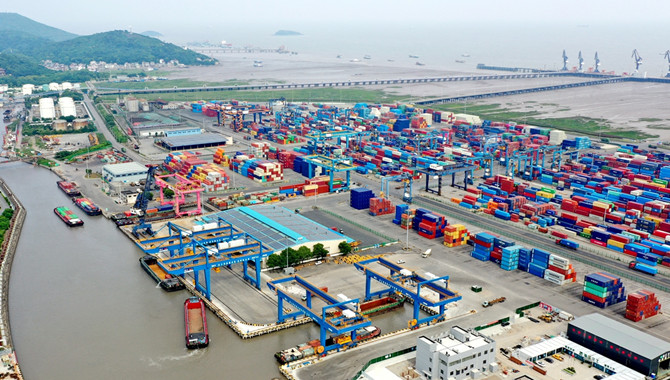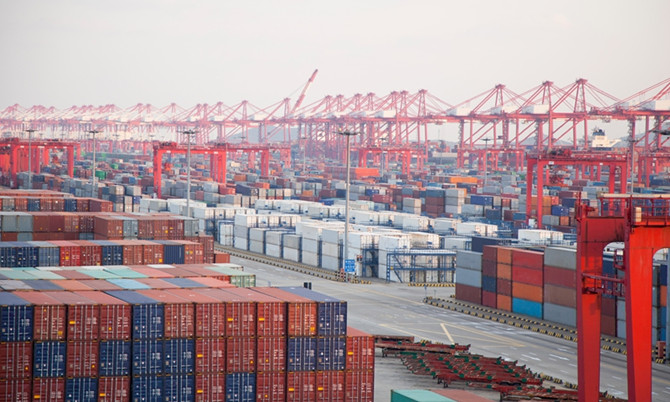
Sea shipping freight costs have seen a sharp drop in China since June, resulting in an increase in foreign orders to Chinese traders, the Global Times has learned from industry insiders.
Observers pointed out that the steady decline in the shipping index illustrates that China's supply chain and economic growth are stabilizing. They also see this as a bright prospect for China's foreign trade going into the second half of the year.
A Ningbo-based international trade service company focusing on China-US trade told the Global Times on Friday that it had seen a significant rise in demand for customs clearance since mid-June, which they said should be attributed to declining shipping freight rates.
"With the increasing efficiency of the shipping supply chain, freight rates for major routes have fallen. The steady decline of the shipping index has sent a positive signal that export enterprises have resumed production and port transportation has steadily picked up," the company said.
A manager surnamed Hu from an air conditioner exporter based in South China's Shenzhen told the Global Times on Friday that last year, in addition to high prices in the entire shipping market, it was also difficult to obtain shipping container space.
"Now, as shipping prices fall, the difficulty in ordering containers has been eased. We only have to book a container four weeks in advance, compared to three months in the fourth quarter of 2021," said Hu.
Hu also noted that in most cases, sea freight costs for export orders are borne by overseas customers.
"When sea freight costs were high last year, overseas customers were not willing to order, which led to serious excess inventory in our warehouse. Now, with the decrease of sea freight costs, the export business has also begun to recover," Hu said.
A shipping agent based in Shanghai also told the Global Times that spot rates on some routes from China to Europe and the US have fallen recently, with rates for the US west coast dropping to $7,000 per standard container at the end of June from around $13,000 before the Spring Festival in early February this year.
"Container rates from China to the US have been above $10,000 for 10 months. The average price of a 40-foot container from China to US west coast ports increased from $1,500 in early 2020 to more than $20,000 in September 2021. The rate began to decline to $15,000 starting 2022," the agent explained.
Against this backdrop, the number of container lines at Ningbo-Zhoushan Port reached 300 by the end of June, a new record high, according to a statement sent from Ningbo-Zhoushan Port to the Global Times on Thursday.
Among them, routes to Southeast Asia increased by nearly 30, covering Vietnam, Thailand, Malaysia and other countries.

The China (Export) Containerized Freight Index dropped 1.2 percent on Friday on a weekly basis, data from the Shanghai Shipping Exchange (SSE) showed.
The Shanghai (Export) Containerized Freight Index (SCFI) has also fallen from a high this week, down more than 17 percent from January, according to SSE.
The Tianjin Shipping Index (TSI), a barometer for foreign trade shipping prices in northern China, ended at 1,883.11 in June, a drop of 3.39 percent from January. The fall in international container freight rates is the main factor causing the decline of TSI, according to the Tianjin International Trade and Shipping Service Center on Monday.
The Tianjin Container Freight Index (TCI) closed at 3,073.01 by the end of June, down 13.37 percent from the start of the year. TCI hit 3,539.83 in December, 2021, an increase of more than five times from the figure in May 2020.
For foreign trade enterprises, this will obviously help reduce their logistical burden, and some previously low value-added products may be able to be exported again, Bai Ming, deputy director of the international market research institute at the Chinese Academy of International Trade and Economic Cooperation, told the Global Times on Friday.
"China has done what it can to keep the supply chain smooth. But foreign trade for the second half of the year still depends on demand from China's trade partners," Bai noted.
Source: Global Times
The opinions expressed herein are the author's and not necessarily those of The Xinde Marine News.
Please Contact Us at:
media@xindemarine.com



 Ningbo Containerized Freight Index Weekly Commentar
Ningbo Containerized Freight Index Weekly Commentar  Ningbo Containerized Freight Index Weekly Commentar
Ningbo Containerized Freight Index Weekly Commentar  Ningbo Containerized Freight Index Weekly Commentar
Ningbo Containerized Freight Index Weekly Commentar  BIMCO Shipping Number of the Week: Bulker newbuildi
BIMCO Shipping Number of the Week: Bulker newbuildi  Ningbo Containerized Freight Index Weekly Commentar
Ningbo Containerized Freight Index Weekly Commentar  Ningbo Containerized Freight Index Weekly Commentar
Ningbo Containerized Freight Index Weekly Commentar